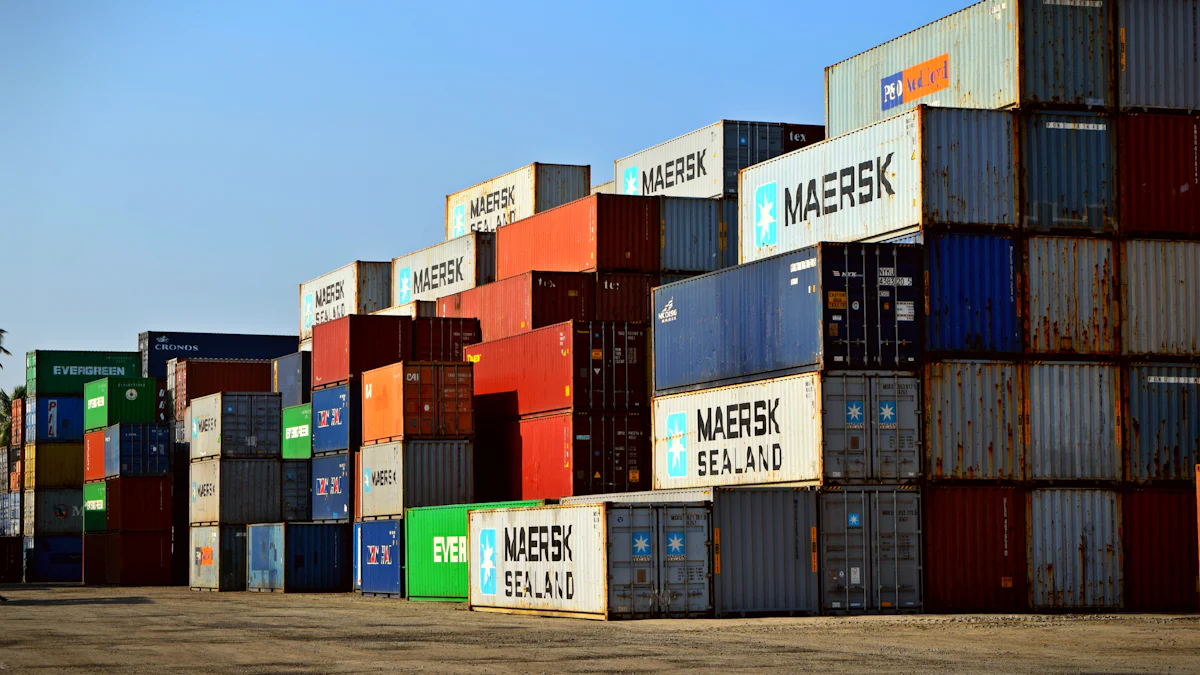Big Data Transforming the Logistics Industry in 2025

Big data has revolutionized how you approach the logistics industry. It involves analyzing massive datasets to uncover patterns and insights that drive smarter decisions. In 2023, the big data in the logistics industry market reached $4.3 billion, with projections of over 21.5% annual growth. By 2025, innovations like real-time visibility and self-driving trucks will redefine supply chain management. Companies like JUSDA lead this transformation, offering intelligent solutions that optimize operations and enhance efficiency.
Key Takeaways
Big data helps logistics by making better decisions and saving time. Companies can guess demand and manage stock with data tools.
Automation and smart tools lower costs and make customers happier. AI and IoT make work faster and improve delivery accuracy.
JUSDA's JusLink platform uses many technologies to show real-time updates. It helps businesses handle tricky supply chains easily.
The Current State of Big Data in the Logistics Industry
Adoption of Big Data in Supply Chain Operations
Big data has become a cornerstone of modern supply chain operations. You now have access to tools that analyze vast amounts of data to improve decision-making and streamline processes. Companies increasingly rely on big data and analytics to predict demand, optimize inventory, and enhance delivery efficiency. By integrating data analytics into supply chain management, you can identify bottlenecks, reduce delays, and improve overall performance. This adoption has transformed the logistics industry, enabling businesses to respond quickly to market changes and customer demands.
Key Use Cases: Route Optimization, Last-Mile Delivery, and Warehouse Automation
Big data and analytics have unlocked innovative solutions for critical logistics challenges. Route optimization is a prime example. DHL’s Smart Truck uses real-time data from GPS and traffic systems to adjust routes dynamically, cutting miles driven by 15% and reducing fuel consumption. Similarly, UPS employs advanced route optimization software across its fleet, saving costs and improving delivery times.
Last-mile delivery, which accounts for 53% of shipping expenses, benefits significantly from big data. Automated systems reduce reliance on manual processes and address driver retention issues, making delivery faster and more reliable.
Warehouse automation also thrives on big data. Automated systems reduce processing time, maximize space utilization, and improve inventory management. For example, automated warehouses use high-rise shelves and narrow aisles to increase storage capacity while optimizing demand forecasting. These innovations not only cut operational costs but also enhance customer satisfaction through faster and more accurate order fulfillment.
Benefit | Description |
|---|---|
Reduced Processing Time | Automation speeds up processes and reduces handling time, allowing for quick measurement of thousands of parcels. |
Maximized Space Utilization | Automated systems can use narrower aisles and high-rise shelves, significantly increasing storage capacity. |
Improved Inventory Management | Automation optimizes inventory management, preventing shortages and enabling better demand forecasting. |
Reduced Operational Costs | While initial investments are high, automation leads to savings in staff costs, handling, and inventory errors. |
Strengthened Customer Satisfaction | Faster order processing and reduced errors enhance customer experience and loyalty. |
Long-term Sustainability | Automated systems contribute to sustainable practices by optimizing resource use and reducing waste. |
JUSDA’s Role in Driving Big Data Adoption
JUSDA has emerged as a leader in leveraging big data to transform supply chain management. Its JusLink Intelligent Supply Chain platform integrates IoT, cloud computing, and big data to provide real-time visibility and collaboration. By adopting advanced analytics, JUSDA helps you optimize delivery schedules, track shipments, and manage inventory dynamically. The platform’s ability to unify data from multiple systems ensures seamless operations, making it a vital tool for businesses navigating complex global supply chains. JUSDA’s innovative approach empowers you to reduce costs, improve efficiency, and deliver exceptional customer experiences.
Benefits of Big Data in Logistics

Enhanced Operational Efficiency Across the Supply Chain
Big data transforms how you manage supply chains by improving operational efficiency. Real-time data from IoT sensors allows you to monitor performance and make informed decisions. Predictive analytics identifies bottlenecks, helping you optimize asset utilization and avoid disruptions. With end-to-end visibility, you can track shipments, evaluate supplier performance, and uncover inefficiencies.
Here are some key benefits you gain:
Enhanced visibility improves decision-making and productivity.
Accurate data analysis helps you plan better and manage inventory effectively.
Proactive solutions to interruptions boost overall efficiency.
By leveraging these tools, you can streamline operations and achieve higher productivity across the supply chain.
Cost Reduction Through Data-Driven Insights
Data-driven decision making plays a critical role in cutting costs. Optimizing routes reduces transit times and fuel expenses. Real-time data sharing enhances resource mobilization, ensuring efficient fleet management and last-mile delivery. Accurate inventory management prevents overstocking and stockouts, improving profitability.
Consider these cost-saving strategies:
Route optimization minimizes fuel costs and travel time.
Effective labor planning increases productivity and reduces expenses.
Continuous data sharing ensures efficient resource allocation.
These insights enable you to allocate resources wisely and reduce operational costs without compromising service quality.
Improved Customer Experience with Advanced Analytics
Advanced analytics revolutionizes how you meet customer expectations. Dynamic scheduling and route optimization ensure faster, more reliable deliveries. Flexible delivery options, such as choosing times and locations, enhance convenience. AI-powered tools like predictive analytics identify trends, enabling you to personalize services.
For example, UPS’s ORION system uses advanced analytics to save millions of miles annually, ensuring precise delivery times. Optimizing e-fulfillment operations improves order accuracy, boosting customer satisfaction. By adopting these technologies, you can deliver exceptional experiences that build loyalty and trust.
Challenges in Implementing Big Data in Logistics
Data Quality and Integration Issues
When you implement big data in logistics, maintaining data quality becomes a significant challenge. Inaccurate or incomplete data often arises because big data includes unstructured or semi-structured information from multiple sources. This can lead to missing details or errors that affect decision-making. You also face integration issues when combining data from different systems. These discrepancies can create fragmented insights, making it harder to analyze trends effectively.
To address these challenges, you need extensive data cleansing and preprocessing. Removing duplicates and correcting errors require time and resources. Additionally, isolated systems, or data silos, can prevent smooth collaboration across your supply chain. Breaking down these silos is essential to ensure seamless data flow and improve operational efficiency.
Skills Gaps in Advanced Analytics and Big Data
The logistics industry faces a shortage of skilled professionals who can handle advanced analytics and big data technologies. Without the right expertise, you may struggle to unlock the full potential of these tools. Investing in training programs for your existing workforce can help bridge this gap. Upskilling employees ensures they can work with AI-powered tools and cloud-based platforms, simplifying data analysis.
Recruiting specialized talent is another strategy you can adopt. By hiring experts in data analytics, you can enhance your ability to extract actionable insights. These efforts are crucial as advanced analytics continues to transform supply chain management, making it more efficient and responsive.
Overcoming Legacy System Limitations
Legacy systems often pose barriers when you integrate big data into your operations. These older systems may lack the scalability needed to handle growing data volumes. Real-time data processing becomes difficult, slowing down response times. Additionally, fragmented data from multiple systems can lead to poor decision-making.
To overcome these limitations, you can modernize your infrastructure by adopting cloud-based solutions and data lakes. These technologies allow you to store and process large datasets efficiently. Ensuring data accuracy and compliance with privacy regulations is also critical. By addressing these challenges, you can create a robust foundation for leveraging big data and analytics in your logistics operations.
Technologies Driving Big Data in the Logistics Industry
Artificial Intelligence (AI) and Machine Learning
AI plays a pivotal role in transforming the logistics industry. It automates logistics scheduling and routing, ensuring faster and more efficient operations. By analyzing historical records and external factors, AI predicts inventory needs and optimizes stock levels. This ensures timely deliveries and reduces waste. AI also enhances route optimization by considering variables like traffic and weather, improving fuel efficiency and cutting costs.
In warehouses, AI systems automate management processes. They predict stock levels, streamline layouts, and improve order fulfillment. These advancements address challenges like fragmented supply chains and market volatility. By connecting networks and optimizing operations, AI enhances overall efficiency and resilience in supply chain management.
Internet of Things (IoT) for Real-Time Supply Chain Visibility
IoT devices revolutionize real-time visibility in the digital supply chain. Sensors and trackers provide live updates on shipments, enabling you to monitor inventory at rest or in transit. Tools like Navisphere® Vision even predict disruptions before they occur, ensuring proactive management.
Consumers increasingly demand transparency. Nearly 97% expect live tracking and timely updates during shipping. IoT integration meets these expectations, fostering trust and loyalty. By 2033, the IoT market in supply chain management is projected to reach $41.8 billion, highlighting its growing importance in creating resilient and customer-centric logistics operations.
Predictive Analytics for Demand Forecasting and Risk Mitigation
Predictive analytics transforms how you forecast demand and mitigate risks. It uses historical data and statistical algorithms to anticipate demand swings and optimize restocking cycles. This ensures timely delivery of goods and reduces operational costs.
Predictive models also identify potential disruptions caused by weather or geopolitical issues. By adjusting supply chain strategies accordingly, you can minimize risks and maintain efficiency. Predictive analytics empowers you to make informed decisions, ensuring smooth operations in an unpredictable logistics environment.
JUSDA’s JusLink Intelligent Supply Chain Platform
JUSDA’s JusLink platform exemplifies how advanced technologies drive big data and analytics in logistics. It integrates IoT, AI, and predictive analytics to provide real-time analysis and end-to-end visibility. The platform optimizes delivery schedules, tracks shipments, and manages inventory dynamically.
JusLink’s ability to unify data from multiple systems ensures seamless operations in complex global supply chains. By leveraging predictive insights, it enhances decision-making and reduces costs. JusLink empowers you to navigate the challenges of the digital supply chain while delivering exceptional customer experiences.
Future Trends and Predictions for 2025

Autonomous Supply Chains and Automation
Autonomous supply chains are reshaping the logistics industry. AI-driven systems now handle demand forecasting and real-time problem-solving, making supply chains more agile. Robotics in warehouses operate autonomously, reducing human error and boosting efficiency. Companies adopting these technologies report a 15% cost reduction and a 25% increase in operational accuracy. Digital tools also improve productivity by 33%, enabling you to streamline operations and meet growing demands. By 2025, automation will become a cornerstone of supply chain management, driving both efficiency and cost savings.
Real-Time Visibility and End-to-End Transparency
Real-time visibility is becoming essential in logistics. Tracking tools and GPS-enabled devices allow you to monitor goods from suppliers to customers. Around 40% of consumers now expect precise updates on their shipments. Cloud-based platforms centralize supply chain data, making it accessible to all stakeholders. AI and machine learning analyze this data to predict disruptions and optimize operations. As Nidhi Gupta, CEO of Portcast, highlights, these technologies drive decisions that significantly impact supply chain ROI. By adopting these solutions, you can enhance transparency and build trust with your customers.
Widespread Adoption of Advanced Analytics in Logistics
Advanced analytics is transforming how you manage logistics. Enhanced demand estimation helps you predict customer needs more accurately. Inventory optimization reduces costs while improving service levels. By deciphering patterns in large datasets, you can make better decisions and boost operational efficiency. Nearly 79% of Chief Supply Chain Officers are now investing in training to drive analytics adoption. This widespread shift ensures that by 2025, data analytics will play a pivotal role in optimizing logistics operations.
JUSDA’s Vision for the Future of Supply Chain Management
JUSDA envisions a future where big data and analytics redefine supply chain management. Its JusLink platform integrates predictive analytics, IoT, and AI to deliver real-time insights and end-to-end visibility. By unifying data from multiple systems, JusLink empowers you to optimize delivery schedules, track shipments, and manage inventory dynamically. JUSDA’s commitment to innovation ensures that you can navigate the complexities of global logistics with confidence, achieving both efficiency and customer satisfaction.

JUSDA Solutions
To provide you with professional solutions and quotations.
Big data is revolutionizing logistics by enhancing supply chain efficiency and customer satisfaction. Tools like IoT and predictive analytics optimize operations and reduce risks. JUSDA’s innovative platforms empower you to navigate complexities with ease. By 2025, data-driven solutions will redefine logistics, ensuring agility and transparency in global operations.
See Also
Unlocking Supply Chain Efficiency Through Big Data Insights
Transforming Supply Chain Strategies Using Big Data Analytics
Future Logistics Transformed by Artificial Intelligence Solutions
Exploring AI's Hidden Benefits for Modern Logistics
Navigating Future Logistics Through Advanced Digital Innovations
